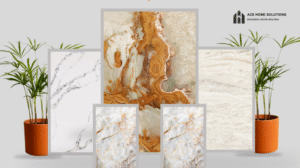Which is better for your home: marble or vitrified flooring?
Choosing the right flooring is a big decision that will affect the look, feel, and long-term value of your dream home. Vitrified tiles and marble are two of the most popular choices on the market. Both have their pros and cons. So, which one is best for your home?
Let’s do a thorough comparison based on all the important things.
What is Marble?
Over millions of years, marble has changed from one type of stone to another. Because of its unique veining, elegance, and luxurious look, no two slabs are alike, which makes it a classic choice for high-end interiors.
Pros of Marble:
• It has a unique natural beauty and texture
• It stays cool naturally, making it perfect for hot places like India
• It increases the value and feel of a property
• It lasts a long time if cared for properly
Cons of Marble:
• It is porous and easily stains.
• It needs to be sealed and polished regularly;
• It is slippery when wet;
• It costs a lot of money and takes a lot of work to install;
What are Vitrified Tiles?
Engineered ceramic tiles called vitrified tiles are made by fusing clay, silica, quartz, and feldspar at very high temperatures. The result is a glossy, hard, non-porous surface that is long-lasting, easy to care for, and comes in a range of finishes, such as ones that look like marble.
Pros of Vitrified Tiles:
• Affordable and simple to put together
• Requires little upkeep and is naturally stain-resistant
• Comes in a wide range of styles, textures, and finishes
• Works well in wet areas like kitchens and bathrooms
Vitrified tiles have some drawbacks:
• They don’t have the rich, natural feel of marble;
• They can crack when hit hard,
• Designs that are all the same may look less real,
• It’s hard to replace just one tile.
Look and feel of the composition
• Marble: A natural stone with unique veining and texture that works well in fancy and artistic spaces.
• Vitrified Tiles: Made from clay, silica, and pigments at high temperatures. They are flexible and can look like marble, wood, or stone finishes.
How long does it last, and how to take care of it
Hardness:
• Marble: Softer; can easily chip or scratch
• Vitrified Tiles: Hard and resistant to scratches
Porosity:
• Marble: High porosity, needs to be sealed, and can get stains easily.
• Vitrified Tiles: They don’t absorb water and don’t get stained easily.
Lifespan:
• Marble lasts 20 to 50 years with the right care.
• Vitrified tiles last 15 to 20 years while still looking good.
Cleaning:
• Marble: Needs cleaners that don’t change the pH and polishing every so often.
• Vitrified Tiles: Easy to clean; no sealing or special care needed.
Price and installation:
• Marble: ₹200 to ₹1,000+ per sq ft, depending on the type and finish. Installing it costs more in labour and finishing.
• Vitrified Tiles: ₹60 to ₹300 per square foot, which includes installation. Pre-cut sizing makes it easy to lay and finish faster.
Feel and Comfort:
• Marble: Feels naturally cool and luxurious, which is great for hot weather but might be too cold in the winter.
• Vitrified Tiles: More durable underfoot, but they work with underfloor heating systems.
Design and Aesthetics
• Marble: Each piece is different, making it perfect for high-end, luxurious interiors.
• Vitrified Tiles: These tiles come in a wide range of styles, from marble lookalikes to wood, textile, and abstract prints. They are perfect for modern and creative spaces.
Use and Environmental Suitability
• Marble: Works best in dry indoor spaces like bedrooms and living rooms. If not treated, it can be slippery in wet areas.
• Vitrified Tiles: Great for places with a lot of foot traffic and moisture, like bathrooms, kitchens, and outdoor patios. They also come with anti-skid options.
Effect on the environment
• Marble: A natural material that lasts a long time, but the way it is mined can harm ecosystems.
• Vitrified Tiles: Made in factories (which use a lot of energy), but some brands offer eco-friendly options made from recycled materials.
A Quick Look at the Comparison
Source:
• Marble: a type of natural stone
• Vitrified Tiles: Made of material
Appearance:
• Marble has unique veining and natural textures.
• Vitrified Tiles: A wide range of polished and printed finishes
Long-lasting:
• Marble: If you take care of it, it will last a long time.
• Vitrified Tiles: Very tough and resistant to wear.
Taking care of:
• Marble: High—needs to be sealed and polished
• Vitrified Tiles: Low—easy to clean with a wipe
Water Resistance:
• Marble: Low—porous and can soak up water
• Vitrified Tiles: High, non-porous, and resistant to moisture
Installation Time:
• Marble: takes a long time and a lot of work
• Vitrified Tiles: easy and quick to install
Price:
• Marble: Usually high
• Vitrified Tiles: Less expensive
Different Designs:
• Marble: only natural patterns are allowed
• Vitrified Tiles: Many different styles, such as wood, marble, stone, and abstract designs
Being good for the environment:
• Marble: Natural but requires a lot of quarrying;
• Vitrified Tiles: Uses a lot of energy, but there are some eco-friendly options.
Which One Is Best for You?
Pick Marble:
• If you want a classic, luxurious look and are ready to spend money on long-term luxury.
• You don’t mind doing more work to keep it up;
• Your climate is warm, or you use underfloor heating;
Pick Vitrified Tiles:
• If you need flooring that lasts a long time and doesn’t cost a lot,
• if you want a variety of designs and quick installation, or
• If you’re covering wet or high-traffic areas, choose Vitrified Tiles.
The Final Decision
There is no clear winner in the marble vs. vitrified debate. The best flooring for you depends on how it looks, how useful it is, and how much money you have.
• Marble adds timeless beauty and character to your home, but it costs more to care for and maintain.
• Vitrified tiles are great for practical lifestyles because they are modern, easy to clean, and give you design freedom. The Best of Both Worlds:
Some homeowners are now using both types of flooring:
Marble in living rooms or entrances for a wow factor and vitrified tiles in kitchens, bathrooms, and hallways for their usefulness.
Why Should You Choose Ace Marbles & Granites?
When it comes to picking between marble and vitrified tiles, quality, where they come from, and how much you know about them are all very important. Ace Marbles & Granites is the best place to go for both natural and man-made flooring solutions.
• Premium Selection: We have a carefully chosen selection of high-end imported marbles and advanced vitrified tiles that will fit any design idea and budget.
• Professional Help: Our knowledgeable staff will help you compare materials not only based on how they look, but also on how well they work, how well they fit, and how much they will be worth in the long run.
• Full Support: We make sure your flooring journey goes smoothly, from choosing and customizing to getting it delivered on time and helping you install it.
• Focus on sustainability: We get our materials from responsible sources and offer eco-friendly options so that your dream home fits with the values of the future.
Ace Marbles & Granites makes sure you choose a beautiful floor that fits your style, whether you want something classic or something more modern.





